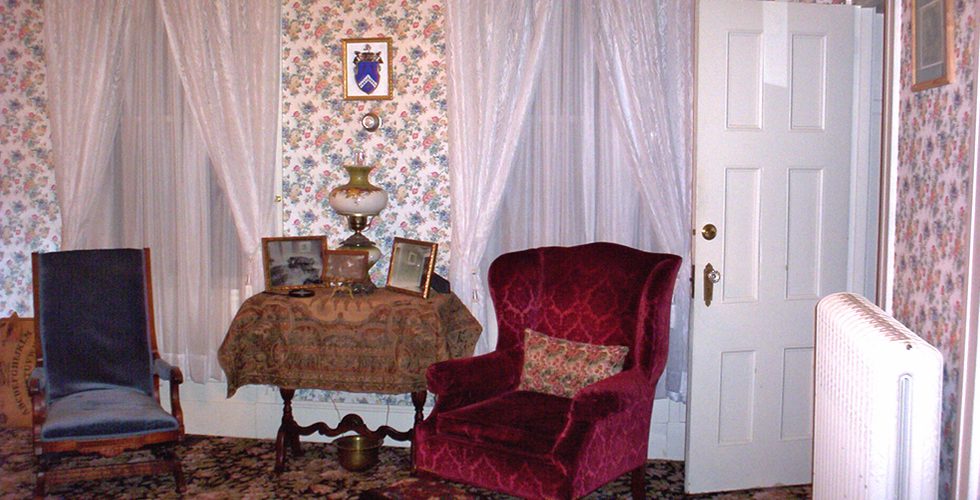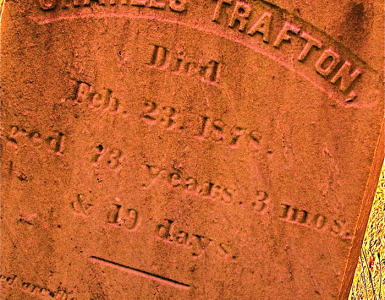by Kat Koorey
First published in April/May, 2004, Volume 1, Issue 2, The Hatchet: Journal of Lizzie Borden Studies.
I have a recurring dream. It is a pleasant one, where I crawl and climb all around the inside and outside of a majestic Victorian building. I climb the roof like a rock climber, crouching, balancing, studying every shingle, and looking in every window. Within, I usually find some ancient and forgotten chamber where all secrets are buried. This room usually takes the form of a dusty library and I am enthralled by the discovery of all this bounty! I revel in the knowledge of a hidden room or a disappearing ceiling and can’t wait to bring my friends who are like-minded, who also share the delight of new knowledge and who also can climb and cling to ceilings or walls or rooftops!
Last night I dreamed a similar dream—this time with Jason Alexander as my cohort. Of course, he whined and moaned and hoarded money on the adventure of discovery as we searched this huge old structure from attic to cellar. We did find a hidden staircase, but it turned out to be hidden only from the public, to whose welfare the building was dedicated as a school. An anomaly of this dream was that we arrived by skateboard. And when we found what we were looking for, it was my mother looking chipper and strong after all these years of missing her. I usually find some treasure in the houses I investigate!
Never had I ever imagined this dream becoming real! The feeling of privilege, the need to explore, the finding of secrets, all of these things I have dreamed came true March 4th, 2004. How often does that happen? It was more amazing to me than any dream and the real people involved were truly friends— wonderful new friends who wished to experience my joy and wonder at seeing what they had to share with me. They were the keepers of the house for the absent mistress who owned the keys to my wish—the door was unlocked, thrown open— and my dream was about to be lived.
Am I really here? I am entering the house that Miller built, and Borden made it his— uniquely his, with alterations, a barrier torn down, a barrier erected, steam heated radiators, large master bedroom, nice sized office—but a narrow back stair shared with the maid. The master, mistress and maid traveled that same small stairway morning, noon, and night, day after day after day, while the girls, Emma and Lizzie, had the front entry as theirs.
Possibly Abby preferred that tightly-walled back stair where she could rest against the wall on the way up, or liked the idea of private steps, where no capricious stepdaughter could knock her down to her injury or death? Those girls rarely used that staircase, except to go to the attic to get into a trunk seasonally or look at the seal cape hanging there like a black bat from the rafters. They had to use that private master/maid stairway for any attic errand because their rooms in the front of the house were locked off from the rest. There was no pass-through, and so each separate generation, the girls and the elder folks, had to make do with an occasional visit to the other faction’s part of the house.
Entering through the side door, I paused, and leaned against that screen, which has been replaced over the years so that it is not THE screen door—I leaned and looked out over the dark park adjacent where Mrs. Adelaide Churchill’s substantial house once stood—North, to a much lower level, and crooned “Mrs. Churchill, doo come over! Someone has killed Father.” I said this with a bit of a Scarlet O’Hara accent, as I had not yet been in town 3 hours in order to gain the Fall River intonations that I love.
I believe my sister Stefani filmed this but really I was caught up in my own altered state. If fact, I may have directed her to “take a picture of this” or “film that”; I don’t recall. I was somewhere else in that house of many memories; I was in my own dream. It was as if I had been there before and so it was natural and unnatural at the same time. Of course, that was because of the many photographs and stories told over the years from other’s pilgrimages.
This was our pilgrimage, Stef’s and mine. She had been here before and called me from the sitting room in July 1997. That self-portrait Polaroid of me on the phone with Stef was still attached to my refrigerator, pride-of-place!
Because Stefani was invited to Fall River, I was not going to let anything stop me from accompanying her! I hauled out my credit card. Through her, I was going to travel, see Fall River, meet new friends, and eat out! That first day was filled with getting to the airport ahead of time, flying (after only levitating in my dreams at night for 18 years), experiencing security checks and the strange interior temperatures of airports, leaving a balmy Florida on an 82 degree day, and arriving in hustling bustling Boston where I had lived for 3 years in the early 1970’s. The temperature in Boston was a chilly 44 degrees; hazy and drizzly. I had no eyes for Boston. Let’s get to Fall River!
Bill Pavao had arranged to give us this tour. Martha McGinn had given her kind permission and though we had just that morning been in a spring-like Florida, now we were about to immerse ourselves in the quintessential Fall River, Massachusetts experience— a long look through the Borden murder house at #92 Second Street, at night!
As I paused at the screen door, looking out at the Fall River air Lizzie had breathed, the house felt like home and the atmosphere was not strange, but rather, familiar. I asked Bill and Stef to go ahead of me, and they entered the sitting room chattering as new comrades.
My first instinct was to use the restroom, so I would not be distracted later. It was like I was closing my eyes until I was ready so that the house played out in front of me.
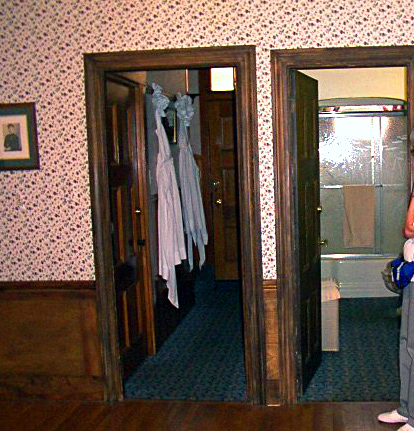 I found out this bathroom off the kitchen was my first surprise. It is deep and includes a shower. Where the shower is located was where the old sink room had been. Bill showed me the wall in the entryway and had me feel where it had been covered over and then wallpapered. I felt the earlier existing doorway! This was very close to the side entrance, and apparently the sink was set into the rear south wall. It had been possibly 4 feet deep, where there was no way that Emma, at the sink, could espy Lizzie tearing up a dress at the cupboard near the stove. She would have had to step out and look down the hall to see anything. Maybe she heard the tearing sound and looked out? Or maybe Lizzie mentioned something or maybe Emma knew ahead of time and was watching?
I found out this bathroom off the kitchen was my first surprise. It is deep and includes a shower. Where the shower is located was where the old sink room had been. Bill showed me the wall in the entryway and had me feel where it had been covered over and then wallpapered. I felt the earlier existing doorway! This was very close to the side entrance, and apparently the sink was set into the rear south wall. It had been possibly 4 feet deep, where there was no way that Emma, at the sink, could espy Lizzie tearing up a dress at the cupboard near the stove. She would have had to step out and look down the hall to see anything. Maybe she heard the tearing sound and looked out? Or maybe Lizzie mentioned something or maybe Emma knew ahead of time and was watching?
My next instinct was to close all the doors into the kitchen. With Bill and Stef off on their own tour, I found after pulling to every door—there were 3!—that it made a kind of hallway. Because the stove sits out into the kitchen to make room for the original chimney area behind, there is a partial wall there. Closing the entryway hall door, the dining room door, and the sitting room door made this area into a small hallway. I don’t know the significance of this but it showed me that the kitchen seemed much larger with the doors closed. Maybe Bridget stood at that door into the sitting room, which was always kept closed, listening…? She would be near the stove but out of the way of it, there is that much room. And she would be facing the door to the dining room. If anyone came she could very easily seem to be moving from kitchen to dining room, as she kept the table there set always ready for a meal, though I can’t imagine waiting to rush to that table fare Bridget served to that household!
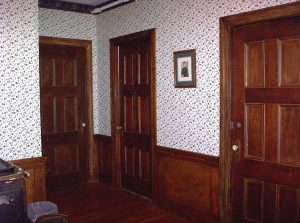 Surely Bridget would listen, as the life of that house was the sitting room. Talks of wills or money or land, notwithstanding—Bridget would be interested in her own status in the household, whether any transgression had been noted or observed, and she may have kept an ear out for any gossip of the neighbors. What other form of entertainment was there in her day and age?
Surely Bridget would listen, as the life of that house was the sitting room. Talks of wills or money or land, notwithstanding—Bridget would be interested in her own status in the household, whether any transgression had been noted or observed, and she may have kept an ear out for any gossip of the neighbors. What other form of entertainment was there in her day and age?
Upon opening the doors, I also recognized the spot in the kitchen where Lizzie sat and rocked and probably watched the proceedings by the doctors and the authorities on the murder day. Because a careful analysis of the testimony shows her seat placed firmly in the area of the kitchen where the entry door and the dining room door open from, I noticed she could keep one eye out, if she had a mind to, as to what some of the people in her house were doing— entering and leaving, going down cellar, and viewing anyone coming and going thru the dining room, from that vantage point. They said her eyes were closed but I think there might have been the glint of an understated roving gaze.
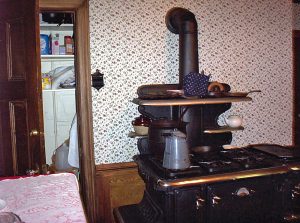 I proceeded to the kitchen closet door, on the other side of the stove in the southwest corner, and opened that and noted the shallow shelves. For some reason, the closet was much deeper than the shelves. It gives the impression that larger items were stored in front, taking up most of the room. This is the closet from which Lizzie was seen taking a piece of her Bedford Cord dress to tear and burn at the stove on the Sunday after the murders. Surely this cupboard had been searched on Thursday and during Saturday’s more thorough search? Bridget, whose bailiwick this was, had left the house Thursday night, but returned Friday to work and stayed Friday night and stayed Saturday and left Saturday night, not ever again to sleep in the house. When did Lizzie stow it there, if even innocently? Surely if that dress had been hidden in that closet since Thursday, Bridget or the police would have found it—yet, like a magician, Lizzie pulls parts of it out of that closet Sunday morning and then that dress is gone forever— burned into legend.
I proceeded to the kitchen closet door, on the other side of the stove in the southwest corner, and opened that and noted the shallow shelves. For some reason, the closet was much deeper than the shelves. It gives the impression that larger items were stored in front, taking up most of the room. This is the closet from which Lizzie was seen taking a piece of her Bedford Cord dress to tear and burn at the stove on the Sunday after the murders. Surely this cupboard had been searched on Thursday and during Saturday’s more thorough search? Bridget, whose bailiwick this was, had left the house Thursday night, but returned Friday to work and stayed Friday night and stayed Saturday and left Saturday night, not ever again to sleep in the house. When did Lizzie stow it there, if even innocently? Surely if that dress had been hidden in that closet since Thursday, Bridget or the police would have found it—yet, like a magician, Lizzie pulls parts of it out of that closet Sunday morning and then that dress is gone forever— burned into legend.
I heard a sound! A tread, not strong, not loud, but the actual approach of a person up the outside entry stairs! The wood reverberated. Someone was coming! I stood my ground, almost in a defensive stance, legs apart and sturdily squaring me. Who approaches?
The key in the side door lock jingled, such a familiar sound, such an odd moment in time. Who would walk thru that door? Andrew who had his keys always about him, Andrew who might walk these halls without blame if he chose to? Some part of me recognized the fact that anyone connected to the house, out of all the worthy souls who volunteer their time and help out here when they can because of their dedication- this might well be who was come a’calling, and I would be the one who appeared as a ghost to them! My mind smiled. Oh to see their face!
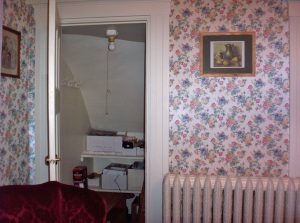 The door opened and there paused a woman in 19th century mourning garb! Our startled gazes probably mirrored the other! I was no longer sure of anything and I guess I was a surprise to this lady as well! A moment—a pause—then I spoke with a welcoming grin, and introduced myself and named my absent sister and the magic words “Bill Pavao.” She relaxed and introduced herself as Shelly. It makes me wonder now if she has ever wondered what each opening of that door would bring within her sight and ken!
The door opened and there paused a woman in 19th century mourning garb! Our startled gazes probably mirrored the other! I was no longer sure of anything and I guess I was a surprise to this lady as well! A moment—a pause—then I spoke with a welcoming grin, and introduced myself and named my absent sister and the magic words “Bill Pavao.” She relaxed and introduced herself as Shelly. It makes me wonder now if she has ever wondered what each opening of that door would bring within her sight and ken!
We had a friendly chat while she looked about for her hatchet. Opening and closing drawers, all she found was some lethal-looking scissors. I have a photo of her leaning over her scissors she had taken from the drawer, a malevolent look upon her face—I had asked her to act as if that were the murder weapon, since she happened to have been holding them. She is a pro, and instantly went into character, though the real character she plays was acquitted. This demonstration provided me with a lot of questions: if Lizzie killed out of rage, why didn’t she just pick up a pair of sewing scissors in the guest room/ sewing room and attack Abby? A person who acts on impulse will grab whatever is handy—the carving knife, the scissors, the flat iron. But, upon finding that Shelly was looking for her hatchet in the kitchen drawer, maybe it’s not such a stretch after all, keeping that in the kitchen rather than in a dusty box in the cellar—it certainly is ‘handy’!
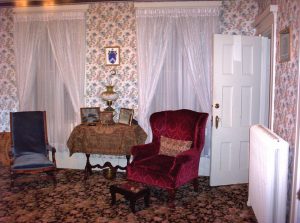 After excusing myself, I was about to enter the sitting room. I glanced into the dining room. Shelly had moved there and was talking quietly to Bill. Stef was around as well. I only kept track of those two when I wanted them. I would call out a name gently and I would hear a voice answer. Bill was usually ‘twain us—so he would echo my call to my sister. It was a vocal relay. I suppose if one were genteel (I can be in company for a period of time), and of an earlier century, and one wanted to call out for someone, a voice relay team would be helpful, in that, if the windows were open, the neighbors need not hear too much of the business going on in the Borden house. That is, if, in case, one had a third ally. I doubt any two people in that earlier Borden house of isolation, had a third ally there in anyone . . .
After excusing myself, I was about to enter the sitting room. I glanced into the dining room. Shelly had moved there and was talking quietly to Bill. Stef was around as well. I only kept track of those two when I wanted them. I would call out a name gently and I would hear a voice answer. Bill was usually ‘twain us—so he would echo my call to my sister. It was a vocal relay. I suppose if one were genteel (I can be in company for a period of time), and of an earlier century, and one wanted to call out for someone, a voice relay team would be helpful, in that, if the windows were open, the neighbors need not hear too much of the business going on in the Borden house. That is, if, in case, one had a third ally. I doubt any two people in that earlier Borden house of isolation, had a third ally there in anyone . . .
Then to the sitting room—the heart of the house, the heart of the master Andrew. This place where his heart was stopped prematurely by a hatchet-wielding specter, on a horrifying day of blood and gore!
Even so, the sofa-side of the sitting room was not that interesting to me. I had seen countless pictures of it and I have a wall just like it (mine is better decorated I might add). My interest was in the south side of the room that no one ever notices, except when they sit or recline on that replica of that famous sofa. I knew the curator Bill, with the help of Len Rebello, had furnished the house to period and true to the testimony in the major source documents of the Trial and the Inquest. I had attempted as much on our discussion Forum, but needed too much help combing the written material that I soon gave up. Here was the depiction, as exactly as could be managed, of “the other side of the sitting room”—the south side, which is the “Kelly” side. There were two easy chairs and a high table between, draped with a tapestry. There was also a built-in shelf unit near the mantle, in the southeast corner, and opposite and formerly corresponding to that was a closet that opened under the stairs. Thus it had a steep-angled ceiling. Apparently the shelving on the east wall had once been a closet. It can be seen on the floor plans in the books.
This remaining closet interested me because the sitting room closets figure into the Borden family habits as to where they kept their things for the outdoors, and which area was considered the master’s and which the girl’s.
In the preliminary hearing, which is a gold mine of extemporaneous detail not elicited in court at the trial, and which is Bridget’s first voice we have saved for us by Mr. Jennings and his descendents, we can find to what use the elder Bordens put this closet:
Page 61+
Q. Did you have a clothes closet in the kitchen?
A. No Sir.
Q. Were there not closets connected with any of the rooms down stairs?
A. There was one in the sitting room, I think.
Q. What was kept there?
A. I do not know what they kept; a basket with clothes in it.
Q. Mrs. Borden had her bonnet and shawl down stairs?
A. Yes Sir, she kept them in the closet in the sitting room; sometimes her common shawl was there.
Q. If she wanted to go out, she could go to the closet in the sitting room and get her bonnet and shawl, and go out without going up stairs?
A. Yes Sir.
Q. What else was kept there?
A. Some clothes belonging to Mr. Borden, I guess.
Q. This jacket he put on in the morning, was not a dressing gown, but a common cardigan jacket?
A. Yes Sir.
Q. Where was that kept?
A. In the sitting room, as you go into the sitting room from the kitchen; there was a nail there.
Q. By the stove?
A. Yes Sir.
Q. In the sitting room closet, beside the bonnet and shawl, and the outside gear Mrs. Borden kept there, what clothing did Mr. Borden have there?
A. I used to see coats there sometimes, old coats.
It is not clear to which closet she refers. The closet, which still exists under the stairs and which is still pretty much in the shape it was in the Borden days, gives a feeling of real intimacy with the former occupants. It is like going through their drawers to be able to look into the personal closet of the master and mistress of 92 Second Street! These un-renovated closets are an especial view into the Borden past and into their daily life. Their clothing, coats, bonnets and shawls shed the dried, decayed skin cells and hairs of their owners in those closets, and would have been redolent of the Fall River winter skies and damp. It truly is like looking into a time-travel doorway. The hooks are contemporary to the time and may be original and so the Borden essence still remains in the closets for me!
At this point Bill shocked me by attacking the sofa! Aroused from my reverie, I saw him shoving it around, loudly proclaiming that we would get to the bottom of the sofa’s original position! Oh how charming! He remembered! He huffed that sofa this way and he puffed that sofa that way. Standing there watching his enthusiastic display, we were still unsure of the sofa’s true position.
You see, the controversy stems from a wall that would seem to be a Victorian decorator’s nightmare. The wall is too short for an old-fashioned (and I mean old-fashioned in 1892!) horsehair sofa that was 7 feet, 1 inch long. The wall itself is 9 feet, 4 inches including the doorjamb, and it has been maintained that the picture on the wall above the sofa was centered, while the sofa was not! There are two groups pitted against each other on this worthy issue—forget there was murder done here! There were casters on the original couch so we really don’t know its normal position. Because that gigantic picture appears centered on the wall in all the crime scene photographs, I have maintained that the couch would have to have been centered under that picture. If not, it means that the mistress of the house did not have a say in the matter. At this point I always seem to become Abby, arguing that it doesn’t look right, no matter what Dr. Bowen said in his testimony.
Shelly jumped right into the spirit of the moment and while I, Abby, watched, she had the sofa centered and attempted, with her long gown, to enter the room from the kitchen, without bumping into the mantle, which does jut out considerably. The essence of the argument is that a full-figured woman with all her skirts about her would not easily pass through that kitchen doorway with the sofa centered under the picture. She waltzed right in with a smile of triumph, and then killed the deal by studying the photograph too closely. She was our swing vote and she swung toward one opinion and then to the other. The ability to see both sides is an admirable trait but among Bordenites can lead to strangling, or worse! Luckily for her, and with Bill’s guidance, we were really having fun and with a light heart I proceeded to the front entry foyer.
(Just between you and me, now we are off in the foyer, I think that the killer had moved that couch or had it moved into position so that the arm of it over-lapped that dining room doorway. It would have been extremely convenient to reach Andrew’s exposed head and up-turned face with a weapon that had a length of 12 or 24 inches. Hiram Harrington tells us that Lizzie admitted to him her solicitude to Andrew as he laid down upon the sofa, an event so astounding to Hiram that just that made her seem guilty, and in my where-there-is-smoke-there-is-probably-fire mind, these actions of caring for Andrew may be a cover-up by Lizzie of the real act of moving the sofa into a better position for an attack from the doorway. Abby would have had pride in her decorative sense, and having a couch centered under a picture which is almost the centerpiece of the room makes sense—else she should have moved the picture!)
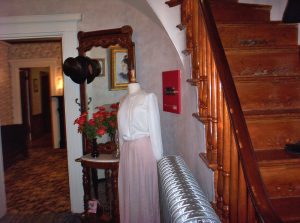 In the foyer for the first time, I was aware that I was entering the domain of the two Borden girls. Here, on display, is Lizzie’s real clothing adorning a mannequin: lady-like Pink! It is a sweet and innocent color, yet probably from her later days as Lizbeth at Maplecroft, as this is displayed with the kind consent of a descendent of one of Lizbeth’s servants. Pink! What about blue? Blue was supposedly her favorite color for her outfits, at least at #92. Emma tells of 10 dresses at the trial, all predominately blue in color, only two of those belonged to her, Lizzie having eight! Upstairs, in what became Emma’s room, there is another fine example of Lizbeth’s clothing, and that also is pink!
In the foyer for the first time, I was aware that I was entering the domain of the two Borden girls. Here, on display, is Lizzie’s real clothing adorning a mannequin: lady-like Pink! It is a sweet and innocent color, yet probably from her later days as Lizbeth at Maplecroft, as this is displayed with the kind consent of a descendent of one of Lizbeth’s servants. Pink! What about blue? Blue was supposedly her favorite color for her outfits, at least at #92. Emma tells of 10 dresses at the trial, all predominately blue in color, only two of those belonged to her, Lizzie having eight! Upstairs, in what became Emma’s room, there is another fine example of Lizbeth’s clothing, and that also is pink!
The most astonishing thing about these outfits, besides their color, is that they seem rather small, for the mannish and large-jawed, big-cheeked girl depicted in the papers, who stood her trial in front of all the world. This fiend, or this victim of the system, was about a size 6 in our sizing today. Elizabeth Montgomery, who played our Lizzie in the TV movie, The Legend of Lizzie Borden, was not much bigger, as her outfit from the movie belongs to the house. To find those youngish and petite clothes in pink in the foyer was as if she was standing there still, awaiting Andrew coming home from the post office. “Any mail for me?” would be her innocent cry. A letter! A letter! Plenty of time for Lizzie to read, and then read it again, and then dream over it, and then formulate her reply in her mind, thinking about it, savoring it, until maybe at night, alone in her room with a lamp, to avoid the elder folks, sitting down to write her reply to her friend, which would then generate another letter! How much time our Lizzie must have had on her hands. And there her clothing still stands, in her stead, awaiting a letter near the front door.
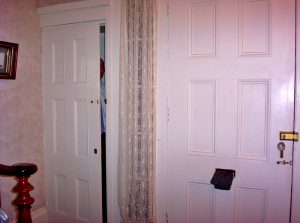 The front door was Lizzie’s responsibility to unlock, and leave on the spring lock, every morning. That Thursday morning of the crimes, while Emma was away, Lizzie did not do that simple chore. For over 100 years folks have been asking why not? The front door, not being open to Andrew’s key that morning, gave Mrs. Kelly a reason to see him trying to get in, it gave the inmates of the house warning of his return, and it also provides a big question in the case . . . if Andrew had tried to enter the house by the side screen door first that morning, why hadn’t Lizzie let him in? She told Mr. Knowlton that she was in the kitchen when Andrew returned. The screen had a hook that would keep Andrew out. Did he call out to be let in? No one asked that question and no one answered it. Just where were you Lizzie, and why did you not let your father in?
The front door was Lizzie’s responsibility to unlock, and leave on the spring lock, every morning. That Thursday morning of the crimes, while Emma was away, Lizzie did not do that simple chore. For over 100 years folks have been asking why not? The front door, not being open to Andrew’s key that morning, gave Mrs. Kelly a reason to see him trying to get in, it gave the inmates of the house warning of his return, and it also provides a big question in the case . . . if Andrew had tried to enter the house by the side screen door first that morning, why hadn’t Lizzie let him in? She told Mr. Knowlton that she was in the kitchen when Andrew returned. The screen had a hook that would keep Andrew out. Did he call out to be let in? No one asked that question and no one answered it. Just where were you Lizzie, and why did you not let your father in?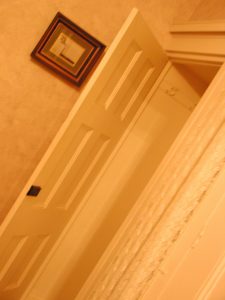
Next to the front door there is a controversial closet. The closet is shallow with hooks on the walls. Mr. Phillips loved that little closet. He took a picture of it in Lizzie’s defense. For whatever reason, he remarked in his article, The Borden Murder Mystery, In Defence of Lizzie Borden that “The police also claimed that no person could have remained concealed in the house for upwards of an hour and have remained undiscovered. I now disclose, it never having been used before, a photograph I took showing a closet at the foot of the front stairway, its door partially open. It was a large closet, and Andrew J. Jennings, chief counsel for Miss Borden, was then peeking from inside the closet through a crack in the door into the hall.” Why Jennings would support his junior Phillips in this little charade, there is no knowing, but for Phillips sake I wanted a picture of Bill in the closet, recreating the photo of which Phillips was so proud.
When Bill moves, he moves fast, so much positive energy encased in that lean body— whoops! He was gone! He was in the closet! I asked him to please open the door a crack and he did. I took my picture. I didn’t see him there. However, later, after opening the digital images in the computer, there was a picture of Bill smiling from the closet! How can that be when I didn’t see him in the original moment? I realize now that my camera can do what Phillips’ camera couldn’t — automatically zoom. By standing closer to the closet, one might have been able to see Jennings in there that day when Phillips shot his picture. His assertion, then, that someone could hide in the closet, with the door ajar, and still be hidden, makes no sense when tested.
But one thing becomes an odd coincidence worthy of pointing out the irony: That Bill Pavao had played Billy Borden in the Ed McBain, Lizzie Borden: Case Reopened, video, and so here I was, taking a modern-day picture of Billy Borden in the closet, smiling, in the Borden’s front hall!


